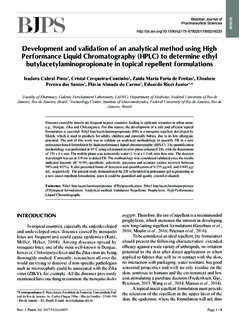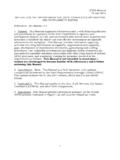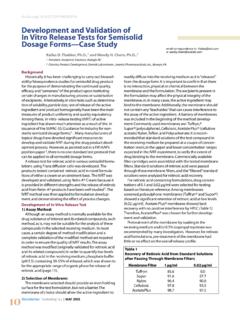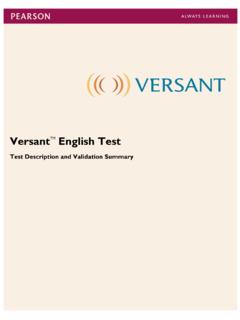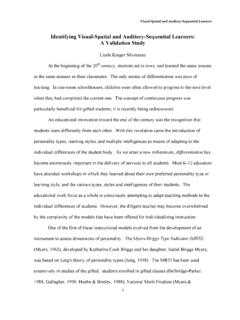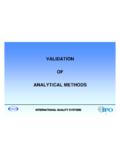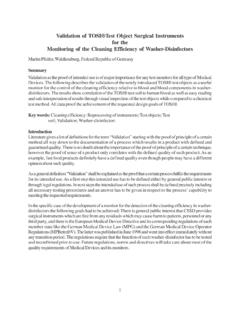Transcription of VALIDATION OF ANALYTICAL METHODS FOR …
1 FAO food AND NUTRITION PAPER68 VALIDATION OFANALYTICAL METHODSFOR food CONTROLA Report of a Joint FAO/IAEA Expert Consultation2-4 December 1997 Vienna, AustriaFood and Agriculture Organization of the United NationsRome, 1998 Joint FAO/IAEA Expert ConsultationValidation of ANALYTICAL METHODS for food Control2-4 December 1997, ViennaCONTENTSPage1. ANALYTICAL METHODS IN Role of of Performance VALIDATION CRITERIA FOR METHOD ELABORATION OF ANALYTICAL METHODS FOR ALTERNATIVE PROCEDURES FOR ESTIMATING PERFORMANCE Quality Requirements for OF FAO/IAEA Expert ConsultationValidation of ANALYTICAL METHODS for food Control2-4 December 1997, Vienna1. INTRODUCTIONA Joint FAO/IAEA Expert Consultation on VALIDATION of ANALYTICAL METHODS for FoodControl was held in Vienna, Austria, from 2 to 4 December 1997. The Consultation participantsare listed in Annex 1. The Consultation was opened by Dr.
2 James Dargie, Director, JointFAO/IAEA Division, who welcomed the participants on behalf of the Directors-General of bothFAO and welcoming the participants, Dr. Dargie outlined the increased emphasis and importanceof Codex activities and standards within the Joint FAO/IAEA Division, especially as they relate tointernational trade. Many of these standards involve chemical analysis of food products and suchanalyses must be conducted with appropriate and validated ANALYTICAL METHODS . Up to the time ofthis Consultation, the VALIDATION requirements of a method used for Codex purposes have beenrigourous and in some instances Codex Committees have requested extensive collaborativestudies. There are, however, alternative VALIDATION procedures which this Consultation has beenasked to consider. For a method to be accepted and used by national governments, the validatedmethod must be both practical and suitable for use.
3 Dr. Dargie underlined the importance of theConsultation in providing international guidance and recommendations in this area. He alsostressed the importance of the Consultation in guiding future work within the recently establishedFAO/IAEA Training and Reference Centre for food and Pesticide control . He pointed out thatthe fundamental objective of this Centre was to assist member nations in implementing Codexstandards to facilitate international trade in food and agricultural commodities and thereby assistsustainable food Consultation Secretary, Mr. Anthony Whitehead, added his welcome to theparticipants and reminded them that two points should be considered during their , it is important that recommendations made by the Consultation be based on sound scienceas a primary consideration. Mr. Whitehead pointed out that important decisions will be madebased upon the Consultation recommendations, especially as regards the requirements for foodquality and safety in the global food trading system.
4 Those decisions must be based on properscience in order to accommodate risk analysis Whitehead also asked the Consultation to consider the constraints and barriers facedby developing countries in applying method VALIDATION requirements that are not always practicalfor their needs. He stressed the importance of flexibility so as to provide alternatives for countriesneeding assistance in these Whitehead provided the participants with the basic objectives of the Consultation,which were: to review existing international METHODS VALIDATION schemes; to identify requirements for VALIDATION of METHODS in the ANALYTICAL areas of veterinarydrug and pesticide residues, food additives and environmental contaminants in food ; and to recommend alternative approaches to METHODS VALIDATION which would be practicaland cost effective, and which would consider time and human resource Consultation elected Dr.
5 Dieter Arnold as Chairman and Dr. Jacques Boisseau asVice Chairman. Dr. Richard Ellis was appointed as Rapporteur. In accepting the Chair, also stressed the importance of the Consultation and informed the participants that timelyelaboration of Codex maximum residue limits (MRLs) for veterinary drug residues in foodJoint FAO/IAEA Expert ConsultationValidation of ANALYTICAL METHODS for food Control2-4 December 1997, Viennarequires validated ANALYTICAL METHODS . Workable alternative VALIDATION procedures would assist inproviding such METHODS . Dr. Arnold further noted that guidance on method VALIDATION was in factneeded by several Codex committees and was also vitally important for providing METHODS todetermine compliance with food safety standards within the provisions of the Agreement on theApplication of Sanitary and Phytosanitary Measures (SPS Agreement) and aiding in resolution offood safety disputes with the World Trade FAO/IAEA Expert ConsultationValidation of ANALYTICAL METHODS for food Control2-4 December 1997, Vienna2.
6 BACKGROUNDT here is a continuing need for reliable ANALYTICAL METHODS for use in determiningcompliance with national regulations as well as international requirements in all areas of foodquality and safety. The reliability of a method is determined by some form of a validationprocedure. The Codex Alimentarius Commission (CAC), for example, requires that in order for amethod of analysis to be included in a Codex commodity standard, certain method performanceinformation should be available. This includes specificity, accuracy, precision (repeatability,reproducibility), limit of detection, sensitivity, applicability and practicability, as appropriate. Thisvery often requires an extensive collaborative study be undertaken to obtain the necessary which have successfully undergone this performance review testing have beenconsidered to be validated for purposes of analyses under Codex commodity ideal validated method is one that has progressed fully through a collaborative study inaccordance with international harmonized protocols for the design, conduct and interpretation ofmethod performance studies.
7 This usually requires a study design involving a minimum of 5 testmaterials, the participation of 8 laboratories reporting valid data, and most often includes blindreplicates or split levels to assess within-laboratory repeatability is not practical or necessary to require that all ANALYTICAL METHODS used for food controlpurposes be assessed at the ideal level, especially METHODS for the determination of low-levelcontaminants in foods, such as veterinary drug and pesticide residues. Limiting factors forcompleting ideal multi-laboratory VALIDATION studies include high costs, lack of sufficient expertlaboratories available and willing to participate in such studies, and overall time validated method for the analysis of veterinary drug residues in foods has beenseparately defined by the Codex Committee on Residues of Veterinary Drugs in food (CCRVDF)(1), as an ANALYTICAL method which has been subjected to ruggedness testing and a multi-laboratorystudy for accuracy, precision and reproducibility.
8 These performance factors facilitatedevelopment of inter-laboratory quality assurance documentation and provide consistency ofresults, on which an appropriate method of analysis for food control purposes can be a method would also include appropriate written procedures for sample selection andpreparation as well as the final quantitation of the analyte being the national level there are many METHODS available and used for routine food controlanalyses which have been selected on the basis of their performance characteristics. In manycases, however, these METHODS have not been subjected to inter-laboratory VALIDATION trials. Ananalytical method must be properly validated if it is to be used at the national level forenforcement purposes. Validated METHODS stand on their own merits in contested legal actions innational courts. This situation has been recognized by the Codex Committee on METHODS ofAnalysis and Sampling (CCMAS), which has proposed to the CAC to commence a new workitem using the concept of local or within-laboratory method VALIDATION based on internationalgeneral this environment, the entire area of VALIDATION of ANALYTICAL METHODS used in foodcontrol for Codex purposes has been discussed at length by the CCMAS, as well as the CCRVDFand the Codex Committee on Pesticide Residues (CCPR).
9 All three Committees supported theholding of a consultation to provide expert advice and guidance in this area. The present JointFAO/IAEA Consultation on VALIDATION of ANALYTICAL METHODS for food control was convened forthat FAO/IAEA Expert ConsultationValidation of ANALYTICAL METHODS for food Control2-4 December 1997, ViennaThe Consultation was asked to review present method VALIDATION criteria and approaches inthe light of past experience, taking into account available resources. In doing this, theConsultation was to consider whether ANALYTICAL METHODS for food control purposes could bevalidated under performance-based criteria using either inter-laboratory or intra-laboratory datacombined with laboratory ANALYTICAL quality assurance systems and/or other widely acceptedanalytical performance FAO/IAEA Expert ConsultationValidation of ANALYTICAL METHODS for food Control2-4 December 1997, Vienna3.
10 ANALYTICAL METHODS IN CODEXThe Role of MethodsThe Consultation considered the importance of METHODS of analysis for the elaboration ofCodex standards and their subsequent use in determining compliance to those standards. Theoperating premise of the Consultation was that METHODS should be transferable betweenlaboratories to help ensure the uniform application of Codex standards. A method is considered tobe transferable when it provides equivalent results, taking into account the method performancecharacteristics, when used in other competent laboratories. Proper VALIDATION of the method isinherent in transferability. Validated ANALYTICAL METHODS should be included in Codex Standards inparticular where they are necessary to determine the presence of potentially hazardous substancesin foods, , veterinary drug and pesticide residues as well as other contaminants in foods, whichmay exceed established limits.










